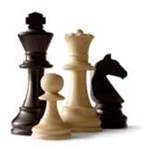
Middle Game Tactics
This is not my work; I shamelessly grabbed it from another ....
1) Do not play with backwards pawns on half-open files if you don't have a reason for it.
2) Attack on the wing where you have more pieces.
3) The pawn structure is like an arrow that points to the wing you need to attack... (Pawns c3 and d4 naturally point to the castled king on g8) Deviating from such a plan always leads to a structural weakness... (c3,d4 and f4 would weaken the light squares, though it does grab e5).
4) The move of a centre pawn denotes the move of a neighbouring pawn... After all we all like centre duos or trios... (c4/d4 or c4/d4/e4) An opening featuring e4 and then b4? often does not make sense positionally... A related point is, we like to keep dark and light squares covered with the pawns next to each other... Knowing this can help you where to organize the assault... It also tells you what the opponent may do.
5) Bishops are best on neighbouring diagonals... (Consider again c3/d4 and then Bd3 and Bc1 as in point 3.) This is also why the fianchetto of 1 bishop is often good... Double fianchetto is often bad or not needed.
6) If you sac in an exchange, then your last rook is often a key defender of the bottom row while it attacks from a distance... Don't exchange it! To a lesser degree this can apply to being up the small exchange... (When not to exchange pieces.) Related is: Exchange double pieces, do not exchange unique pieces.
7) If a doubled pawn is directly facing an enemy pawn, then the offensive value of the pawn is (N - 1) In other words, you cannot make a passer against a minority... That is all things being equal... The defensive value is the same... (When not to allow doubled pawns... When to inflict doubled pawns. How to win a better endgame.)
*Note that there is some danger if the opposer of the doubled pawn is not the spearhead of the formation...
